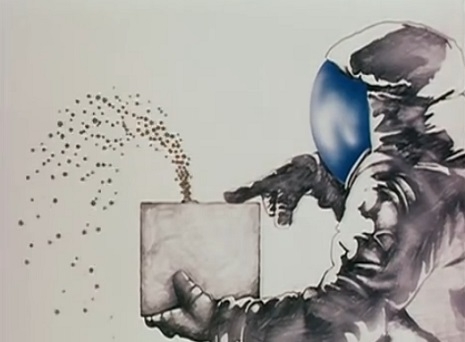
You may not know the name Graham Stark, but you will certainly recognize this stony-faced comic actor from the dozens of British movies in which he appeared, such as the second Inspector Clouseau film A Shot in the Dark, Alfie, Those Magnificent Men in their Flying Machines, The Magic Christian, and Revenge of the Pink Panther. Stark also provided voices for The Goon Show, and regularly featured in TV comedies like The Benny Hill Show and Sykes. When he died last year, at the age of 91, Stark was described as an actor who was frequently cast in supporting roles, but never quite achieved stardom:
“Stark moved on the periphery, appearing in nearly 80 films, often as the fall-guy or put-upon sidekick.”
He was also described as “a close friend of Peter Sellers,” his confidante, who had been best man at all four of Sellers’ weddings.
Stark was regarded in the film world as Sellers’ sycophantic sidekick, who would do anything to brown nose his famous friend. The character actor John Le Mesurier once said of their relationship:
“Graham Stark is the only man in London with a flat up Peter Sellers’s arse.”
Some of the strange things Graham Stark did to appease his friend Sellers have been well documented in various biographies, most assiduously by Roger Lewis in his superb The Life and Death of Peter Sellers (the UK edition not the anemic US version). In this massive volume, Lewis detailed how Stark “had fetched and carried for his pal,” and:
had been so devoted to him, indeed, he’d even allowed Sellers to lock him in the boot of his car, on the pretext of getting him to locate the source of an annoying squeak.
An article Lewis wrote, ten years after Sellers’ death in The Daily Telegraph, he joked about their odd relationship, explaining how:
As a reward for his services, Stark used to be given Sellers’s discarded cameras or hi-fi equipment. He had parts in the Pink Panther films. He was best man at various Sellers weddings, and was taken on holiday to Paris and New York. Stark was the one constant element in Sellers’s zig-zag life, and he didn’t object when Sellers dressed him up as Hitler and had him parade along the Hong Kong waterfront, where he ran into a party of Jewish tourists.

Instead of “laughing along with this,” Stark had his lawyers send a letter threatening legal action:
...three days after the article was published, I received a ferocious letter from Carter-Ruck. Well, not a letter exactly. A declaration of war. “It is untrue that Peter Sellers and/or Blake Edwards talked to our client excitedly of a new penis-enlarging ointment and went to enormous trouble organising a mail-order address in Copenhagen, whence a confederate sent our client a tub of rancid garlic butter.”
Carter-Ruck continued: “Due to the gravity of the allegations our client will require a Statement in Open Court and accordingly proceedings for libel will immediately be issued.” The name and address of my solicitors was demanded, who could accept service of a writ. As, only the previous year, Carter-Ruck had checked a manuscript of one of my own books for defamation, and had charged me £2,415 for the privilege, I suggested that they serve the writ on themselves. (Not my exact wording by any means.)
Lewis “couldn’t take any of it seriously – the paranoid overreaction; the disappearance of common sense and smug pomposity of the legal profession; the sanctimony; the Kafkaesque nincompoopery.” The legal process dragged on for several years, even going to the Court of Appeal. But these actions revealed a far more troubling, and horrific side to Graham Stark.
In August 1990, Lewis and the paper’s lawyers received a letter from a Mrs Shirley Cheevers:
Mrs Cheevers said that “Graham Stark had to creep away pretty smartish with his tail between his legs” when her friend’s niece, then a minor, had visited the actor in a television studio, where she’d gone in a group to watch a recording. Stark “picked her up and showed her a good time”. When she went back to boarding school, her widowed mother “was horrified to discover a pile of letters from Stark, giving in great and obscene and graphic detail descriptions of what he was going to do to her next holiday and what he had done to her already.”
Her family took the documents to a firm of solicitors, Tatton, Gaskell & Tatton, who were ready to take Stark fully to task, but “her mother felt she could not cope with it all and drag her daughter into it anymore”. Stark got away with just a warning and an injunction to keep clear of the schoolgirl. Mrs Cheevers concluded: “None of them has ever forgotten this incident. It has coloured their lives in one way and another ever since.” (It says a lot about the Sixties that no one thought to go to the police.)
Richard Sykes decided to investigate. “I do not have any great hopes,” he said, “but it is worth a try.” By October 1990, however, he had located the child’s surviving family in Hove, East Sussex. Her aunt wrote: “I confirm that my niece was made a Ward of Court in 1967 following our discovery of very explicit correspondence from Graham Stark, including one called The Lesson … The whole episode was a dreadful shock and affected all our lives for a very long time. My niece was corrupted both physically and mentally by this awful man.”
Lewis was incredulous that this was the same man who was attempting to punish both himself and the newspaper for presenting him as:
“contemptible, sycophantic and self-debasing parasite who had willingly allowed himself to be humiliated and treated as a stooge by Peter Sellers, in return for the latter’s patronage and largesse”
Which was surprising considering the number of defense witnesses, including Spike Milligan, film producer Roy Boulting, writer Wolf Mankowitz, presenter David Jacobs and scriptwriter Frank Muir, who all agreed that Stark was “a creepy, humourless sleazeball and hanger-on.”
As Lewis goes onto explain, the child’s aunt had discovered an incriminating stash of letters sent by Stark to her niece, which detailed the actor’s obscene desires for the child:
From the set of a film he was making at Shepperton called Salt and Pepper, starring Sammy Davis Jr and Peter Lawford, in which he portrayed a police sergeant, Stark wrote: “You will be taken to the bedroom where you will strip in front of me … You will put on the black nylon stockings and the very high-heeled shoes … Needless to say under no circumstances will panties ever be worn and I will be able to see your adorable——whenever I wish … I shall arrange to have a car bring you down to the studios for the day.”
Other (much more explicit) material pertains to sado-masochistic scenarios involving corsets, instructions for the child to “parade in front of Bobby “without your panties on” – who was Bobby? – and practical arrangements about dates and phone numbers. Then there’s the contract that Stark wished her to sign: “I hereby sincerely swear that from this day forward I intend to give my body willingly to my lover GRAHAM STARK to do with as he pleases … Should at any time he wish other people to be present to look at me I will not protest.” And so on and so forth.
As Lewis points out, it has taken until the recent exposure of the horrific child and sex abuse scandals involving BBC presenter Jimmy Savile, which was only investigated after his death, for the police to take an interest and action over the long list of allegations from the 1960s and 1970s against celebrity sex abusers. So far, these have included another BBC presenter, the convicted Stuart Hall and most recently the PR guru Max Clifford, who was sentenced to eight years in prison for his indecent assaults on women and girls.
As is becoming apparent celebrity abuse of women and children is far more common than ever supposed. It was only after his death that comic actor Arthur Mullard was revealed to have raped his daughter when she was thirteen, and groomed her as his “sex slave.” The past may be a “another country” but there still appears to have been a willfully perverse and utterly unacceptable attitude towards sexual abuse amongst generations of men during the sixties and seventies, and no doubt beyond.
Read Roger Lewis’s full article “The stark truth about Peter Sellers’ sidekick” here.


























